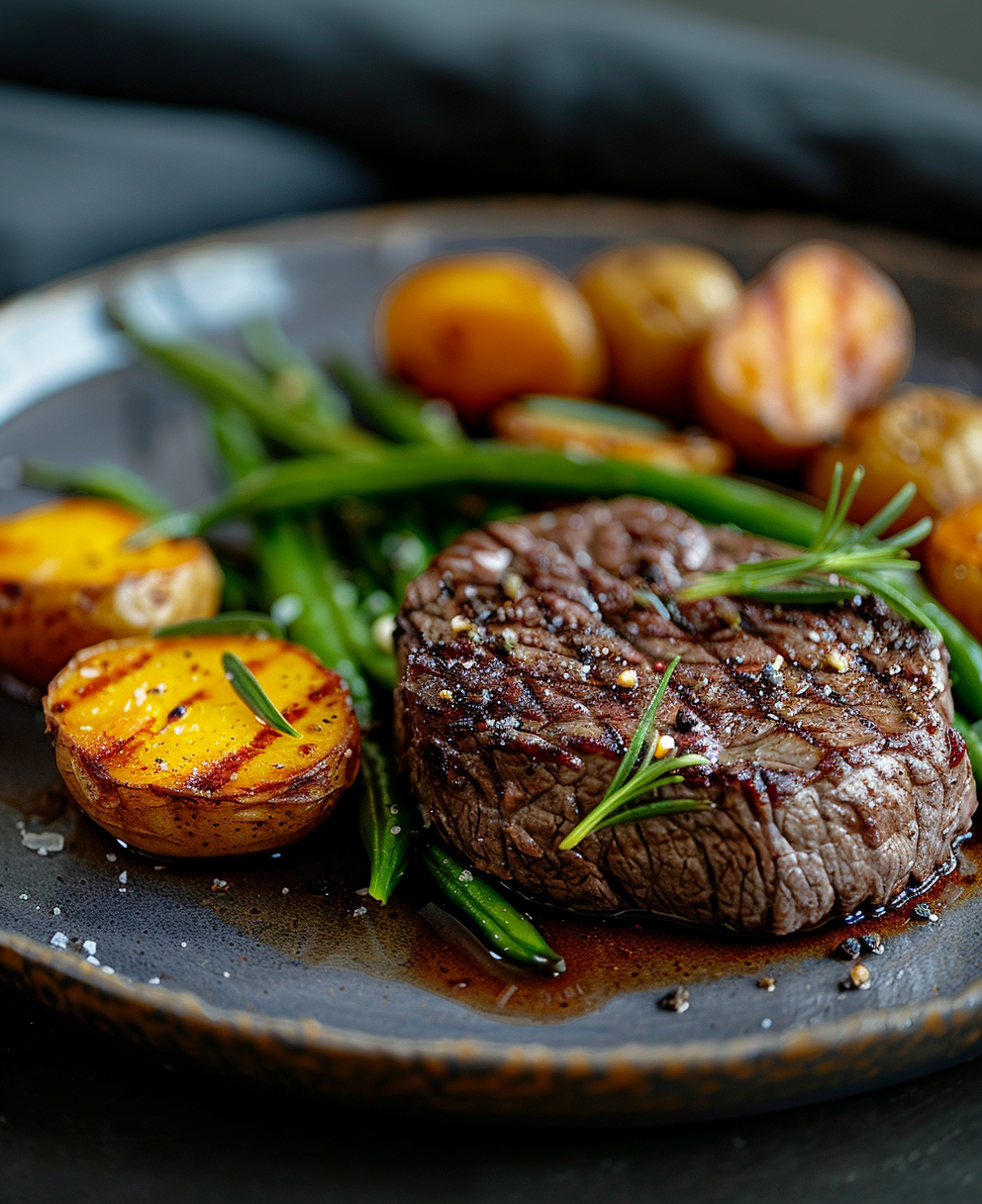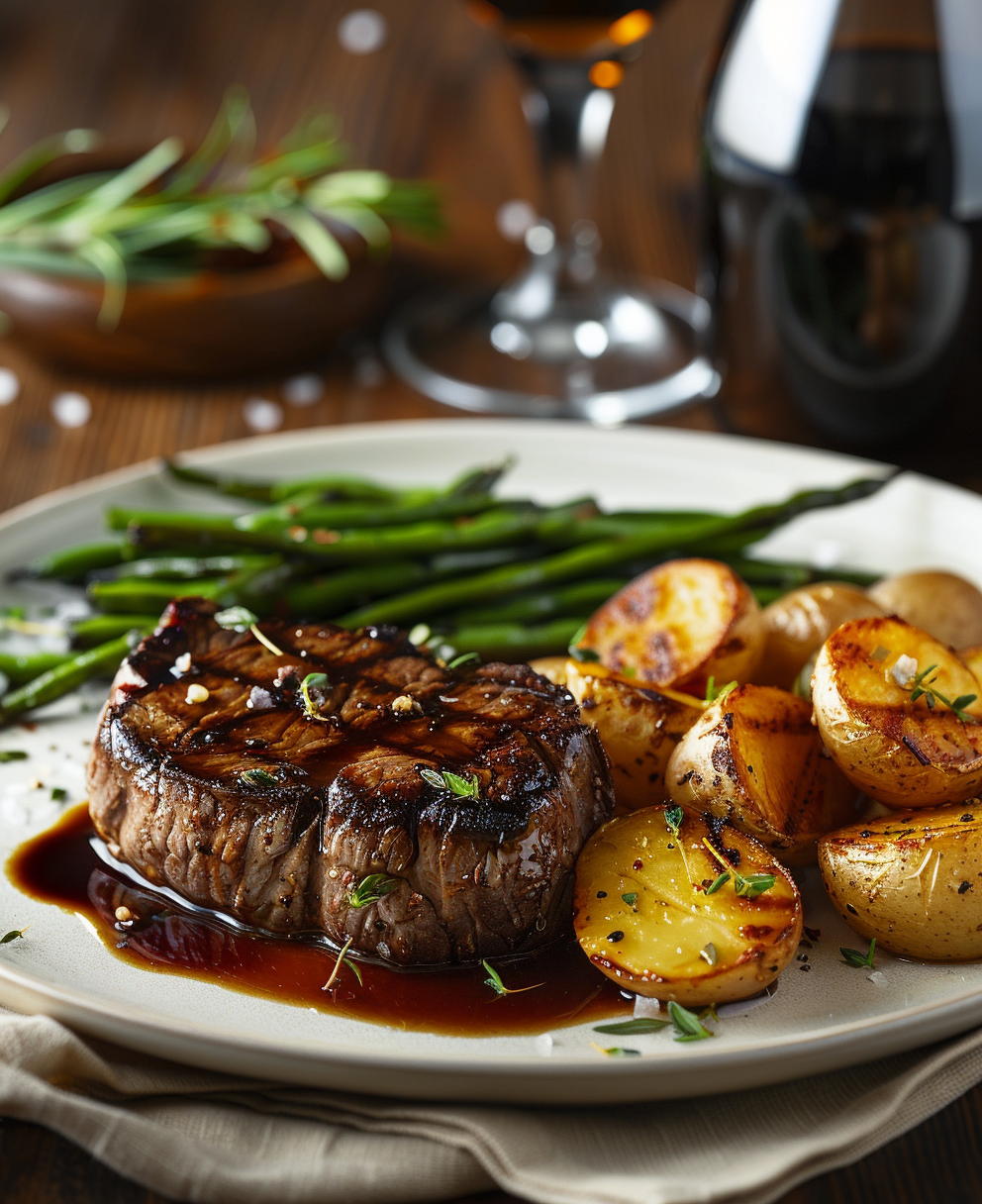
Why This Pan Seared Steak Filet Mignon is a Game-Changer
Picture this: it’s a Friday night, and you’re craving something that feels fancy but doesn’t require hours in the kitchen. That’s when I discovered the magic of pan seared steak filet mignon. It’s tender, juicy, and packed with flavor, yet so simple to make. I still remember the first time I served it to my family—they were speechless (and that’s saying something). This recipe isn’t just about cooking; it’s about creating moments that linger longer than the meal itself.
A Little Background on Filet Mignon
Filet mignon comes from the tenderloin, the most prized part of the cow. Its name translates to “dainty fillet” in French, which makes sense because it’s as delicate as it gets. Back in the day, only royalty and the wealthy could afford this cut. Fast forward to today, and we can all enjoy it at home. I love how modern cooking methods, like pan-searing, bring out its natural flavors without needing fancy sauces or techniques.
Why You’ll Love This Recipe
This pan seared steak filet mignon recipe is a winner for so many reasons. First, it’s quick—perfect for busy weeknights or last-minute dinner plans. Second, it’s versatile. Pair it with mashed potatoes, roasted veggies, or even a fresh salad. And third, it’s foolproof if you follow my tips. Plus, there’s nothing quite like the sizzle of steak hitting a hot pan—it smells like success!
Perfect Occasions to Make This Dish
Whether it’s date night, a birthday, or just a random Tuesday, this dish fits the bill. I’ve served it for holidays, anniversaries, and even casual get-togethers. It’s elegant enough to impress but easy enough to whip up without stress. Trust me, once you try it, you’ll find excuses to make it again and again.
Ingredients
- 2 filet mignon steaks (about 6–8 ounces each)
- Salt and freshly ground black pepper
- 2 tablespoons olive oil
- 2 tablespoons unsalted butter
- 3 garlic cloves, smashed
- 3 sprigs fresh thyme

Substitution Options
- Swap olive oil with avocado oil for a higher smoke point.
- Use rosemary instead of thyme for a different flavor profile.
- If you don’t have fresh garlic, garlic powder works in a pinch.
Preparation
Step 1: Season Generously
Start by patting your filet mignon dry with paper towels. This step is crucial because moisture is the enemy of a good sear. Season both sides generously with salt and pepper. Don’t be shy—seasoning is what builds flavor. Pro tip: Let the steaks sit at room temperature for 20–30 minutes before cooking. This ensures even cooking.
Step 2: Heat Your Pan
Grab your favorite skillet—I use cast iron—and heat it over medium-high heat. Add the olive oil and let it shimmer but not smoke. A hot pan is key to achieving that golden crust we all crave. Imagine the sizzle as the steaks hit the pan—it’s music to my ears. Pro tip: Open a window or turn on the fan because things are about to get smoky!
Step 3: Sear and Flip
Place the steaks in the pan and let them cook undisturbed for 3–4 minutes. Resist the urge to move them around—patience is key here. Flip them over and add the butter, garlic, and thyme. Tilt the pan slightly and spoon the melted butter over the steaks. This step infuses them with rich, aromatic flavors. Chef’s tip: Use tongs to hold the steaks upright and sear the edges for an extra touch of perfection.
Step 4: Rest Before Serving
Once the steaks reach your desired doneness (use a meat thermometer to check), transfer them to a plate and let them rest for 5 minutes. Resting allows the juices to redistribute, ensuring every bite is moist and flavorful. Trust me, skipping this step is one of the biggest mistakes people make.
Timing
Prep time: 10 minutes
Cooking time: 10–12 minutes
Resting time: 5 minutes
Total time: About 25 minutes
Chef’s Secret
Here’s my secret weapon: finish the pan seared steak filet mignon in the oven if you prefer a hands-off approach. After searing, pop the skillet into a preheated oven at 400°F for 5–7 minutes. This method is perfect for thicker cuts and ensures even cooking throughout.
Extra Info
Did you know filet mignon is often called the “king of steaks”? Its tenderness comes from the fact that the muscle it’s cut from does very little work, making it incredibly soft. No wonder it’s a favorite among steak lovers!
Necessary Equipment
- Cast iron skillet or heavy-bottomed pan
- Tongs
- Meat thermometer
- Paper towels
Storage
Leftover pan seared steak filet mignon? Lucky you! Store it in an airtight container in the fridge for up to 3 days. Reheat gently in a skillet with a splash of broth to keep it moist. Avoid microwaving, as it can dry out the meat.
If you’ve made extra, consider slicing it thinly and using it in salads or sandwiches. The flavors meld beautifully, making it a versatile leftover option.
For longer storage, freeze the steak in a freezer-safe bag. Thaw it overnight in the fridge before reheating. Just remember, nothing beats freshly cooked steak, so portion wisely!
Tips and Advice
Always bring your steak to room temperature before cooking. Cold steaks won’t sear properly and may end up unevenly cooked. Use a meat thermometer to nail your preferred doneness: 125°F for medium-rare, 135°F for medium. And don’t overcrowd the pan—cook in batches if needed.

Presentation Tips
- Serve on a warm plate to keep the steak cozy.
- Garnish with fresh herbs like parsley or thyme for a pop of color.
- Drizzle a bit of the pan sauce over the top for extra flair.
Healthier Alternative Recipes
Looking to lighten things up? Here are six variations:
- Grilled Filet Mignon: Skip the pan and fire up the grill for a smoky twist.
- Balsamic Glazed: Add a balsamic reduction for a tangy-sweet finish.
- Herb-Crusted: Coat the steak with crushed herbs and breadcrumbs before searing.
- Sous Vide: Cook the steak sous vide for precision, then sear for a quick crust.
- Mushroom-Topped: Top with sautéed mushrooms and a dollop of sour cream.
- Spicy Rub: Mix chili powder, cumin, and paprika for a bold kick.
Common Mistakes to Avoid
Mistake 1: Skipping the Resting Step
Many people slice into their steak right after cooking, but this releases all the juices. Resting allows the meat to reabsorb its juices, making it more flavorful and tender. Pro tip: Tent the steak loosely with foil while it rests.
Mistake 2: Using the Wrong Pan
A nonstick pan won’t give you that gorgeous crust. Always use a heavy-bottomed skillet like cast iron for optimal heat retention. Pro tip: Preheat the pan for a few minutes before adding oil.
Mistake 3: Overcooking the Steak
Overcooked filet mignon is a tragedy. Use a meat thermometer to avoid guessing. Remember, the steak will continue to cook slightly as it rests.
FAQ
How long to pan sear filet mignon?
Typically, 3–4 minutes per side for medium-rare, depending on thickness. Always use a meat thermometer to confirm doneness.
Is it better to pan sear steak in butter or oil?
Oil is best for the initial sear due to its high smoke point, but butter adds incredible flavor later in the process.
How to pan sear filet mignon and finish in the oven?
Sear the steak in a hot pan, then transfer the skillet to a 400°F oven for 5–7 minutes for even cooking.
How does Gordon Ramsay cook the perfect filet mignon?
Gordon Ramsay often uses a combination of pan-searing and finishing in the oven, adding butter and herbs for extra flavor.
What temperature should filet mignon be cooked to?
Aim for 125°F for medium-rare, 135°F for medium. Adjust based on your preference.
Can I use a nonstick pan for this recipe?
It’s better to use a cast iron skillet for a proper sear, as nonstick pans don’t retain heat as well.
Should I marinate filet mignon?
Filet mignon is naturally tender, so marinating isn’t necessary. Stick to seasoning with salt and pepper.
Can I freeze cooked filet mignon?
Yes, wrap it tightly and freeze for up to 3 months. Thaw in the fridge before reheating.
What sides pair well with filet mignon?
Mashed potatoes, roasted vegetables, and Caesar salad are classic choices.
How do I know when the steak is done?
Use a meat thermometer. For medium-rare, look for an internal temperature of 125°F.
Final Thoughts
There’s something magical about a perfectly cooked pan seared steak filet mignon. It’s quick, delicious, and sure to impress anyone lucky enough to share it with you. Whether you’re celebrating a special occasion or just treating yourself, this recipe is a keeper. So grab your skillet, crank up the heat, and let’s get cooking—you’ve got this!


Pan Seared Steak Filet Mignon
Ingredients
Equipment
Method
- Pat the filet mignon dry with paper towels and season both sides generously with salt and pepper.
- Let the steaks sit at room temperature for 20–30 minutes.
- Heat a cast iron skillet over medium-high heat and add olive oil, letting it shimmer but not smoke.
- Place the steaks in the pan and cook undisturbed for 3–4 minutes.
- Flip the steaks over, add butter, garlic, and thyme.
- Spoon the melted butter over the steaks, searing the edges with tongs.
- Check for desired doneness with a meat thermometer and transfer to a plate to rest for 5 minutes.
